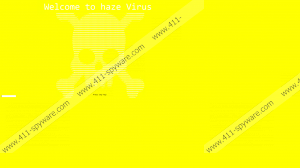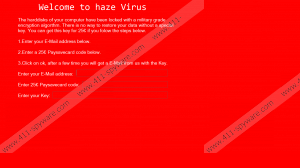Haze Ransomware Removal Guide
If you see a red window “Welcome to haze Virus” covering your Desktop, there is no doubt that a malicious application called Haze Ransomware has infiltrated your computer and opened this window. Ignore the message this window contains even if it claims that malware has encrypted all hard disks on your computer because it is not true. Researchers at 411-spyware.com have revealed that this infection does not perform the encryption of files, so it is not a typical ransomware infection. Consequently, there is no point in purchasing the key for unlocking those encrypted files either. Well, theoretically, the ransomware infection might be updated one day and really encrypt files before opening a window over Desktop, but even in this case, you are not allowed to pay money to the author of Haze Ransomware because you might simply be left without money and your files. Our recommendation for those who discover this ransomware infection on their computers is to disable the infection and delete all its components so that it could never revive again and cause problems. Luckily, Haze Ransomware is not one of those infections that create new files on compromised machines or apply significant changes to the system registry. Because of this, we are sure you could erase this infection yourself even if you have never erased malicious software before.
It is hard not to notice the entrance of the Haze Ransomware browser hijacker because when launched, it opens immediately a flashy window with a message "Press any key". If the key is pressed, it displays a ransom note. It covers the entire Desktop and cannot be closed by clicking X. This ransom note tries to convince users that their files on all hard disks have been encrypted “with a military grade encryption algorithm.” They also find out that these files can only be unlocked with a special key. Only cyber criminals behind Haze Ransomware have it, but users are told that they can purchase it from them. The price of the special key is €25. It is quite cheap if compared to prices of decryption tools more sophisticated ransomware infections offer victims to purchase, but it still does not mean that you should go to send the Paysafecard code worth of €25 to cyber criminals. First, there is no point in doing that because the chances are high that your files have not been encrypted. Second, this infection can be removed from the system even without paying a ransom to cyber crooks. You will first need to access your Desktop, of course. This can be done by pressing two buttons Win+D simultaneously.
The main symptom showing that Haze Ransomware has successfully entered the system is the screen-sized window opened on Desktop. If this ransom note was not opened to users, it is very likely that they would not even know about the entrance of the ransomware infection because this threat enters computers illegally. Ransomware infections usually end up on users’ computers when they open malicious attachments from spam emails. Yes, this type of malware can be distributed via spam emails. Also, you might one day detect Haze Ransomware or another dangerous infection on your system if your RDP credentials are weak. We do not say that it is easy to prevent malicious software from entering the system, but we have no doubt that you could do that with the help of a reputable antimalware tool. You only need to install such a tool on your computer and it will do the rest of the job, i.e., it will protect your system every day.
You cannot keep Haze Ransomware active on your PC because it might get updates and then really encrypt your files. Also, you will continue seeing an irritating window placed over your Desktop. You can erase this infection in two ways. First, you can acquire the malware remover, upgrade it, and then start the full system scan. Second, you can remove all the ransomware components manually from your system. Luckily, it does not drop any files, so it will be enough to remove the malicious file downloaded recently so that the ransomware infection could not launch again.
Haze Ransomware removal guide
- Tap Win+D on your keyboard.
- Launch Task Manager (press Ctrl+Shift+Esc).
- Open Processes.
- Locate the process representing Haze Ransomware and kill it.
- Open Explorer (Win+E).
- Open %USERPROFILE%\Downloads and %USERPROFILE%\Desktop.
- Delete all recently downloaded files.
- Clear Recycle bin.
Haze Ransomware Screenshots:



